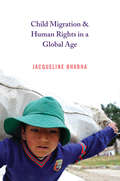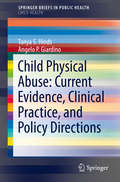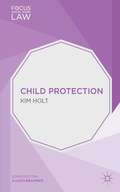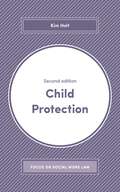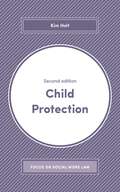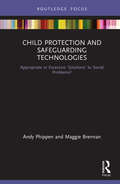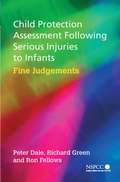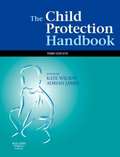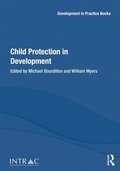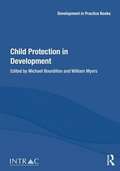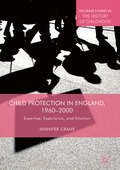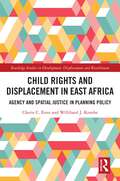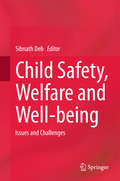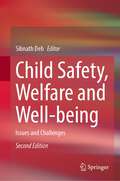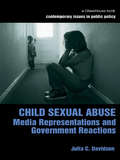- Table View
- List View
Child Labour in South Asia (Contemporary Employment Relations)
by Kishor SharmaChild labour is a serious and contentious issue throughout the developing world and it continues to be a problem whose form and very meaning shifts with social, geographical, economic and cultural context. While the debate about child labour practice in developing countries appears to be motivated by growing competition in labour intensive products brought about by globalization, studies on this issue are both sparse and lopsided. This important book aims to shed light on this debate by documenting the experience of South Asian developing countries which have experienced rapid income and export growth. Based on evidence from Bangladesh, India, Nepal, Pakistan and Sri Lanka, this volume aims to improve our understanding about the link between trade, growth and child labour practices, as well as management of child labour in developing countries.
Child Marriage, Rights and Choice: Rethinking Agency in International Human Rights
by Hoko HoriiThis book addresses the issue of agency in relation to child marriage. In international campaigns against child marriage, there is a puzzle of agency: while international human rights institutions celebrate girls’ exercise of their agency not to marry, they do not recognize their agency to marry. Child marriage, usually defined as ‘any formal marriage or informal union where one or both of the parties are under 18 years of age’, is normally considered as forced – which is to say that it is assumed assuming that are not capable of consenting to marriage. This book, however, re-examines this assumption, through a detailed socio-legal examination of child marriage in Indonesia. Eliciting the multiple competing frameworks according to which child marriage takes place, the book considers the complex reasons why children marry. Structural explanations such as lack of opportunities and oppressive social structures are important, but not exhaustive explanations. Exploring the subjective reasons by listening to children’s perspectives, their stories show that many of them decide to marry for love, desire, to belong to the community, and for new opportunities and hopes. The book, then, demonstrates how the child marriage framework – and, indeed, the human rights framework in general – is constructed on too narrow a vision of human agency: one that cannot but fail to respect and promote the agency of all, regardless of gender, race, religion, and age. This book will be of interest to scholars, students, and practitioners in the areas of children’s rights, legal anthropology, and socio-legal studies.
Child Marriage, Rights and Choice: Rethinking Agency in International Human Rights
by Hoko HoriiThis book addresses the issue of agency in relation to child marriage. In international campaigns against child marriage, there is a puzzle of agency: while international human rights institutions celebrate girls’ exercise of their agency not to marry, they do not recognize their agency to marry. Child marriage, usually defined as ‘any formal marriage or informal union where one or both of the parties are under 18 years of age’, is normally considered as forced – which is to say that it is assumed assuming that are not capable of consenting to marriage. This book, however, re-examines this assumption, through a detailed socio-legal examination of child marriage in Indonesia. Eliciting the multiple competing frameworks according to which child marriage takes place, the book considers the complex reasons why children marry. Structural explanations such as lack of opportunities and oppressive social structures are important, but not exhaustive explanations. Exploring the subjective reasons by listening to children’s perspectives, their stories show that many of them decide to marry for love, desire, to belong to the community, and for new opportunities and hopes. The book, then, demonstrates how the child marriage framework – and, indeed, the human rights framework in general – is constructed on too narrow a vision of human agency: one that cannot but fail to respect and promote the agency of all, regardless of gender, race, religion, and age. This book will be of interest to scholars, students, and practitioners in the areas of children’s rights, legal anthropology, and socio-legal studies.
Child Mental Health: Exploring Systems of Care in the New Millennium
by John Y Powell David Dosser Dorothea Handron Susan Mccammon Sandra A. SpencerUse these system-of-care concepts to better serve children with serious emotional problems and their families!Providing services to children with emotional problems and their families continues to be a major challenge for social workers, family therapists, child mental health advocates, and psychologists in the new century. This valuable book addresses that challenge, detailing theory, principles, and application issues from the vantage points of both consumers and service providers. System-of-care values and practices were developed to address these concerns and meet the needs of these children and families, who tend to receive either no services at all or services that are far too restrictive, at a large cost to the organization providing the services.Child Mental Health: Exploring Systems of Care in the New Millennium identifies salient issues and offers suggestions for addressing the complexities of providing services for these troubled families. It also provides hope and encouragement for family members and professionals by identifying roles and practices that are effective in building collaborative community-based services.This book takes an incisive look at: the benefits and difficulties of partnering between practitioners and families the need for and benefits of partnering between practitioners of various disciplines within the system of care a working model of a wraparound process (the hallmark of the system of care) barriers that prevent effective wraparound services and what causes them the need to help social workers learn parent partnering skills the roles that families can play in the system of care the need for specialized training so that practitioners can learn to assess, understand, and integrate a family's spiritual beliefs into the system of care the development of an interdisciplinary, collaborative practice course at East Carolina University experiential training and shared-classroom experiences for studentsChild Mental Health: Exploring Systems of Care in the New Millennium is a tool that will aid practitioners and consumers alike as they shift their point of view from the provider-as-expert paradigm to one of building partnerships.
Child Mental Health: Exploring Systems of Care in the New Millennium
by John Y Powell David Dosser Dorothea Handron Susan Mccammon Sandra A. SpencerUse these system-of-care concepts to better serve children with serious emotional problems and their families!Providing services to children with emotional problems and their families continues to be a major challenge for social workers, family therapists, child mental health advocates, and psychologists in the new century. This valuable book addresses that challenge, detailing theory, principles, and application issues from the vantage points of both consumers and service providers. System-of-care values and practices were developed to address these concerns and meet the needs of these children and families, who tend to receive either no services at all or services that are far too restrictive, at a large cost to the organization providing the services.Child Mental Health: Exploring Systems of Care in the New Millennium identifies salient issues and offers suggestions for addressing the complexities of providing services for these troubled families. It also provides hope and encouragement for family members and professionals by identifying roles and practices that are effective in building collaborative community-based services.This book takes an incisive look at: the benefits and difficulties of partnering between practitioners and families the need for and benefits of partnering between practitioners of various disciplines within the system of care a working model of a wraparound process (the hallmark of the system of care) barriers that prevent effective wraparound services and what causes them the need to help social workers learn parent partnering skills the roles that families can play in the system of care the need for specialized training so that practitioners can learn to assess, understand, and integrate a family's spiritual beliefs into the system of care the development of an interdisciplinary, collaborative practice course at East Carolina University experiential training and shared-classroom experiences for studentsChild Mental Health: Exploring Systems of Care in the New Millennium is a tool that will aid practitioners and consumers alike as they shift their point of view from the provider-as-expert paradigm to one of building partnerships.
Child Migration and Human Rights in a Global Age
by Jacqueline BhabhaWhy, despite massive public concern, is child trafficking on the rise? Why are unaccompanied migrant children living on the streets and routinely threatened with deportation to their countries of origin? Why do so many young refugees of war-ravaged and failed states end up warehoused in camps, victimized by the sex trade, or enlisted as child soldiers? This book provides the first comprehensive account of the widespread but neglected global phenomenon of child migration, exploring the complex challenges facing children and adolescents who move to join their families, those who are moved to be exploited, and those who move simply to survive.Spanning several continents and drawing on the stories of young migrants, Child Migration and Human Rights in a Global Age provides a comprehensive account of the widespread and growing but neglected global phenomenon of child migration and child trafficking. It looks at the often-insurmountable obstacles we place in the paths of adolescents fleeing war, exploitation, or destitution; the contradictory elements in our approach to international adoption; and the limited support we give to young people brutalized as child soldiers. Part history, part in-depth legal and political analysis, this powerful book challenges the prevailing wisdom that widespread protection failures are caused by our lack of awareness of the problems these children face, arguing instead that our societies have a deep-seated ambivalence to migrant children—one we need to address head-on.Child Migration and Human Rights in a Global Age offers a road map for doing just that, and makes a compelling and courageous case for an international ethics of children's human rights.
Child Migration and Human Rights in a Global Age (PDF)
by Jacqueline BhabhaWhy, despite massive public concern, is child trafficking on the rise? Why are unaccompanied migrant children living on the streets and routinely threatened with deportation to their countries of origin? Why do so many young refugees of war-ravaged and failed states end up warehoused in camps, victimized by the sex trade, or enlisted as child soldiers? This book provides the first comprehensive account of the widespread but neglected global phenomenon of child migration, exploring the complex challenges facing children and adolescents who move to join their families, those who are moved to be exploited, and those who move simply to survive.Spanning several continents and drawing on the stories of young migrants, Child Migration and Human Rights in a Global Age provides a comprehensive account of the widespread and growing but neglected global phenomenon of child migration and child trafficking. It looks at the often-insurmountable obstacles we place in the paths of adolescents fleeing war, exploitation, or destitution; the contradictory elements in our approach to international adoption; and the limited support we give to young people brutalized as child soldiers. Part history, part in-depth legal and political analysis, this powerful book challenges the prevailing wisdom that widespread protection failures are caused by our lack of awareness of the problems these children face, arguing instead that our societies have a deep-seated ambivalence to migrant children—one we need to address head-on.Child Migration and Human Rights in a Global Age offers a road map for doing just that, and makes a compelling and courageous case for an international ethics of children's human rights.
Child Physical Abuse: Current Evidence, Clinical Practice, and Policy Directions (SpringerBriefs in Public Health)
by Tanya S. Hinds Angelo P. GiardinoThis eye-opening monograph challenges professionals across disciplines to take a more thorough and focused approach to addressing child physical abuse at the practice and policy levels. Positing child physical abuse as a public health crisis (as opposed to a more vague “social” one), the authors use empirical findings and clinical insights to advocate for wide-scale reforms in screening, assessment, responses, treatment, and prevention. The book’s social/ecological perspective delves into root causes of physical maltreatment, analyzes the role of family and community risk and support factors, and notes forms of discomfort keeping many professionals from meeting the issue head-on. From there, chapters describe coordinated multidisciplinary efforts for intervention and prevention with the potential to avert all forms of child abuse. Included in the coverage: · Adverse childhood experiences (ACEs) · The non-verbal child: obtaining a history for caregiver(s) · Clinical perspectives on multidisciplinary collaboration Corporal punishment and risk for child physical abuse Intimate partner violence (IPV) and risk for child physical abuse Evolution of child maltreatment prevention Complementary dynamic prevention approach Child Physical Abuse sets out the scope of this ongoing crisis for a wide audience including healthcare providers, child advocates, clinical social workers, public health officials, mental health providers, legislative staff professionals, and members of the lay public, with clear guidelines for effective long-term solutions.
Child Protection (Focus on Social Work Law)
by Kim HoltHow do you apply the principles, structures and processes of the law to everyday practice? Drawing on a wealth of contemporary case examples, this handy pocket book demystifies the legislation on child protection and demonstrates the practical duties and responsibilities of professionals working within this complex area.
Child Protection: Policy And Practice In Complex Child Protection Decisions (Focus on Social Work Law)
by Kim HoltHow do you apply the principles, structures and processes of the law to everyday practice? Drawing on a wealth of contemporary case examples, this handy pocket book demystifies the legislation on child protection and demonstrates the practical duties and responsibilities of professionals working within this complex area.
Child Protection (Focus on Social Work Law)
by Kim HoltHow do you apply the principles, structures and processes of the law to everyday practice? Drawing on a wealth of contemporary case examples, this handy pocket book demystifies the legislation on child protection and demonstrates the practical duties and responsibilities of professionals working within this complex area.Students taking Social Work qualifying undergraduate and postgraduate degrees. Qualifies Social Workers fulfilling their learning development requirements. Students taking non-social work but related degrees, e.g. Community and Youth Work. 2nd / 3rd level students on qualifying Social Work courses (u/g and p/g).
Child Protection and Safeguarding Technologies: Appropriate or Excessive ‘Solutions’ to Social Problems?
by Maggie Brennan Andy PhippenThis book explores, through a children’s rights-based perspective, the emergence of a safeguarding dystopia in child online protection that has emerged from a tension between an over-reliance in technical solutions and a lack of understanding around code and algorithm capabilities. The text argues that a safeguarding dystopia results in docile children, rather than safe ones, and that we should stop seeing technology as the sole solution to online safeguarding. The reader will, through reading this book, gain a deeper understanding of the current policy arena in online safeguarding, what causes children to beocme upset online, and the doomed nature of safeguarding solutions. The book also features a detailed analysis of issues surrounding content filtering, access monitoring, surveillance, image recognition, and tracking. This book is aimed at legal practitioners, law students, and those interested in child safeguarding and technology.
Child Protection and Safeguarding Technologies: Appropriate or Excessive ‘Solutions’ to Social Problems?
by Maggie Brennan Andy PhippenThis book explores, through a children’s rights-based perspective, the emergence of a safeguarding dystopia in child online protection that has emerged from a tension between an over-reliance in technical solutions and a lack of understanding around code and algorithm capabilities. The text argues that a safeguarding dystopia results in docile children, rather than safe ones, and that we should stop seeing technology as the sole solution to online safeguarding. The reader will, through reading this book, gain a deeper understanding of the current policy arena in online safeguarding, what causes children to beocme upset online, and the doomed nature of safeguarding solutions. The book also features a detailed analysis of issues surrounding content filtering, access monitoring, surveillance, image recognition, and tracking. This book is aimed at legal practitioners, law students, and those interested in child safeguarding and technology.
Child Protection Assessment Following Serious Injuries to Infants: Fine Judgments (Wiley Child Protection & Policy Series)
by Peter Dale Richard Green Ron Fellows"This book is especially welcome because of the scholarship and thoughtfulness evident throughout." —Dr Peter Reder, Child Psychiatrist, London How do child protection professionals and courts make judgments on whether serious injuries to infants are due to abuse? If injuries are considered to be the result of abuse, in what circumstances can it be considered safe for the infant to return home? Child Protection Assessment Following Serious Injuries to Infants is concerned with helping child protection professionals and courts make the right decisions and avoid errors that can have disastrous consequences for children and families. Drawing upon the extensive clinical and research experience of the authors, this authoritative text: Reviews research on the causes of child abuse and problems in diagnosing abuse. Examines the views of parents who consider that they have been wrongly accused of child abuse. Draws specific attention to the need to assess potential for change in families and considers in detail how this can be achieved. Highlights skills issues that are necessary for undertaking appropriate assessments. Identifies key factors that are indicative of reunification in some cases, and factors that contraindicate reunification in others. With its evidence-based approach, this book will be a valuable resource for all child protection professionals. It will also be of use to health professionals, legal professionals, researchers, lecturers and students of social work.
The Child Protection Handbook (PDF)
by Kate Wilson Adrian L. JamesThis title is directed primarily towards health care professionals outside of the United States. The new edition of this popular handbook gives an authoritative, informative and accessible account of key areas of child protection practice. Covering research, policy and practice it is relevant to all professionals working in child care. No other book on child protection offers such comprehensive coverage of policy and practice. It provides research findings in all areas of child abuse, latest policies and indications of good practice, plus specialist chapters for different professionals. Chapters have been contributed by known experts in the field, both distinguished academics and practitioners. By combining the latest factual information with sophisticated analysis, it is the ideal course text for child protection programmes as well as meeting the needs of more experienced practitioners, academics and trainers.
Child Protection In Development
by Michael Bourdillon William MyersEvery day millions of children in developing countries face adversities of many kinds, yet there is a shortage of sound evidence concerning their plight and an urgent need to identify the most appropriate and effective policy responses from among the multiple approaches that exist. This collection of journal papers aims to engage with researchers and debates in the field so as to understand better some of the numerous risks confronted by children in developing countries. It highlights the complexity of protecting children in various forms of adversity, challenges conventional wisdom about what protects children, demonstrates why it is essential to consult with children to protect them successfully, and suggests that successful protection must be based on strong empirical understanding of the situation and the perspectives of children and communities involved. The contributors are all experienced researchers and practitioners who have worked for many years with children in developing countries. The book offers suggestions for reform of current child protection policies, based on empirical findings around a range of child protection concerns, including children's work, independent migration, family separation, early marriage, and military occupation. Together, the contributions provide a body of knowledge important to humanitarian and development policy and practice. This book was published as a special issue of Development in Practice. 9780415643993
Child Protection in Development
by Michael Bourdillon William MyersEvery day millions of children in developing countries face adversities of many kinds, yet there is a shortage of sound evidence concerning their plight and an urgent need to identify the most appropriate and effective policy responses from among the multiple approaches that exist. This collection of journal papers aims to engage with researchers and debates in the field so as to understand better some of the numerous risks confronted by children in developing countries. It highlights the complexity of protecting children in various forms of adversity, challenges conventional wisdom about what protects children, demonstrates why it is essential to consult with children to protect them successfully, and suggests that successful protection must be based on strong empirical understanding of the situation and the perspectives of children and communities involved. The contributors are all experienced researchers and practitioners who have worked for many years with children in developing countries. The book offers suggestions for reform of current child protection policies, based on empirical findings around a range of child protection concerns, including children's work, independent migration, family separation, early marriage, and military occupation. Together, the contributions provide a body of knowledge important to humanitarian and development policy and practice. This book was published as a special issue of Development in Practice.
Child Protection In Development (PDF)
by Michael Bourdillon William MyersEvery day millions of children in developing countries face adversities of many kinds, yet there is a shortage of sound evidence concerning their plight and an urgent need to identify the most appropriate and effective policy responses from among the multiple approaches that exist. This collection of journal papers aims to engage with researchers and debates in the field so as to understand better some of the numerous risks confronted by children in developing countries. It highlights the complexity of protecting children in various forms of adversity, challenges conventional wisdom about what protects children, demonstrates why it is essential to consult with children to protect them successfully, and suggests that successful protection must be based on strong empirical understanding of the situation and the perspectives of children and communities involved. The contributors are all experienced researchers and practitioners who have worked for many years with children in developing countries. The book offers suggestions for reform of current child protection policies, based on empirical findings around a range of child protection concerns, including children's work, independent migration, family separation, early marriage, and military occupation. Together, the contributions provide a body of knowledge important to humanitarian and development policy and practice. This book was published as a special issue of Development in Practice. 9780415643993
Child Protection in England, 1960–2000: Expertise, Experience, and Emotion (Palgrave Studies in the History of Childhood)
by Jennifer CraneThis book is open access under a CC BY 4.0 license.This open access book explores how children, parents, and survivors reshaped the politics of child protection in late twentieth-century England. Activism by these groups, often manifested in small voluntary organisations, drew upon and constructed an expertise grounded in experience and emotion that supported, challenged, and subverted medical, social work, legal, and political authority. New forms of experiential and emotional expertise were manifested in politics – through consultation, voting, and lobbying – but also in the reshaping of everyday life, and in new partnerships formed between voluntary spokespeople and media. While becoming subjects of, and agents in, child protection politics over the late twentieth century, children, parents, and survivors also faced barriers to enacting change, and the book traces how long-standing structural hierarchies, particularly around gender and age, mediated and inhibited the realisation of experiential and emotional expertise.
Child Protection Systems in the United Kingdom: A Comparative Analysis
by Nigel Parton Anne Stafford Sharon Vincent Connie SmithThis book identifies and analyses differences between the four UK nations in the way child protection systems are being developed, thought about and put into practice. Covering key areas such as inter-agency working and the role of local safeguarding children boards, it draws out important implications for policy and practice across the UK.
Child Rights and Displacement in East Africa: Agency and Spatial Justice in Planning Policy (Routledge Studies in Development, Displacement and Resettlement)
by Cherie C. Enns Willibard J. KombeFocusing on the intersection of spatial justice, child rights, and planning policy, this book investigates the challenges of resettlement in East Africa, where half of those displaced are children. The challenges created by displacement and resettlement are often considered from an adult-centric perspective by planners and humanitarian and development experts. The spatial injustice of displacement and resettlement, the agency of children, and the application of tools such as Child Participatory Vulnerability Index (CPVI) is siloed, commonly overlooked, or discounted. This book uses a CPVI and rights-based assessment of land-use policies, to investigate resettlement due to conflict and settlement in northern Uganda, floods due to climate change in Dar es Salaam, Tanzania, and urban to rural migration of children due to the aids pandemic in Western Kenya. Case studies from over a decade of field research are integrated with examples from applied planning projects and policy development in the East Africa region. This book uses spatial justice theory to show how child-friendly planning approaches can positively promote child rights in the context of resettlement. Providing important insights on how to enact child-friendly planning in informal settlements, refugee camps, and displacement camps, this book will be of interest to planning and development professionals, and researchers across the fields of children's rights, Development Studies, Planning, and African Studies.
Child Rights and Displacement in East Africa: Agency and Spatial Justice in Planning Policy (Routledge Studies in Development, Displacement and Resettlement)
by Cherie C. Enns Willibard J. KombeFocusing on the intersection of spatial justice, child rights, and planning policy, this book investigates the challenges of resettlement in East Africa, where half of those displaced are children. The challenges created by displacement and resettlement are often considered from an adult-centric perspective by planners and humanitarian and development experts. The spatial injustice of displacement and resettlement, the agency of children, and the application of tools such as Child Participatory Vulnerability Index (CPVI) is siloed, commonly overlooked, or discounted. This book uses a CPVI and rights-based assessment of land-use policies, to investigate resettlement due to conflict and settlement in northern Uganda, floods due to climate change in Dar es Salaam, Tanzania, and urban to rural migration of children due to the aids pandemic in Western Kenya. Case studies from over a decade of field research are integrated with examples from applied planning projects and policy development in the East Africa region. This book uses spatial justice theory to show how child-friendly planning approaches can positively promote child rights in the context of resettlement. Providing important insights on how to enact child-friendly planning in informal settlements, refugee camps, and displacement camps, this book will be of interest to planning and development professionals, and researchers across the fields of children's rights, Development Studies, Planning, and African Studies.
Child Safety, Welfare and Well-being: Issues and Challenges
by Sibnath DebThis volume presents the unique features of child abuse and neglect and discusses proposed as well as experimented protective measures to create awareness about child rights and their implementation. Divided into four sections, the volume discusses (a) the nature and prevalence of child abuse and neglect, risk factors and impact; (b) issues pertaining to child rights with regard to nutrition, health and education; (c) rights of children with disabilities, HIV/AIDS, and in circumstances like disaster and adoption; and (d) field-based experiences of researchers in protecting child rights and preventing child abuse. The most important contribution of this volume is in providing an analysis of the current legal scenario of child protection, emphasizing the rights of different sections of vulnerable children. Professionals and academics specializing in this area from different academic backgrounds and regions have contributed chapters to this volume, creating a global and multidisciplinary forum for discussion. This volume is important for a wide range of professionals and researchers from the social sciences, law, medicine, and behavioral sciences. It is also beneficial for policy makers and law enforcement agencies working with children.
Child Safety, Welfare and Well-being: Issues and Challenges
by Sibnath DebThis book provides a focused and comprehensive overview of the status of children across society, with special reference to emerging features and measures of child safety, welfare, and overall well-being. The book is arranged into four parts covering various dimensions of child welfare and well-being. In this second edition, highly experienced academics, researchers, child rights activities, and policymakers from both developed and developing countries have contributed chapters on topics such as status of children living under institutional care, sexual abuse of male children and tribal girl children, issues and challenges faced by children living in conflict zones, children living on the streets, COVID-19 and its impact on the education of children. The status of marginalized children gets special importance in the second edition. The new chapters include field-based experiences of researchers in protecting child rights and preventing child abuse. It also considers the promising strategies and promising future directions in enhancing effective prevention, intervention and responses to child abuse and neglect. This volume is essential for a wide range of professionals and researchers from the social sciences, law, medicine, and behavioral sciences. It is also beneficial for policymakers and law enforcement agencies working with children.
Child Sexual Abuse: Media Representations and Government Reactions (Contemporary Issues in Public Policy)
by Julia DavidsonChild Sexual Abuse critically evaluates the development of policy and legislative measures to control sex offenders. The last fifteen years has seen increasing concern on the part of the government, criminal justice agencies, the media and the public, regarding child sexual abuse. This concern has been prompted by a series of events including cases inviting media attention and involving the abduction, sexual abuse and murder of young children. The response to this wave of child sexual abuse revelation has been to introduce increasingly punitive legislation regarding the punishment and control of sex offenders (sex offenders are the only group of offenders in British legal history to have their own act), both in custody and in the community. But this response, it is argued here, has developed in a reactionary way to media and public anxiety regarding the punishment and control of sex offenders (who have abused children) and the perceived threat of such offenders in the community.



